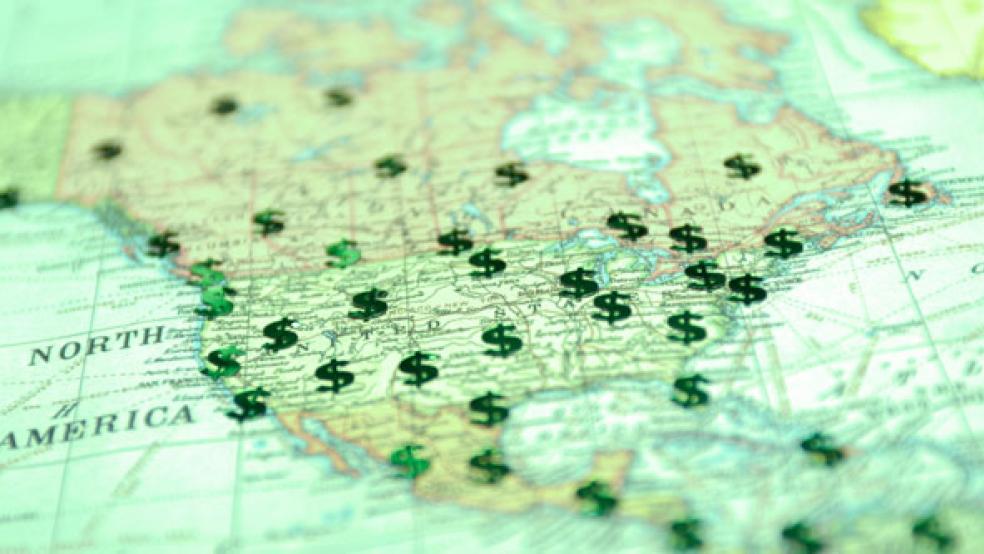Sooner rather than later, the market will figure out that Friday's below-forecast first estimate of fourth-quarter growth is much better news than the headline suggests.
The U.S. economy grew at a 2.6 percent annual rate, the Commerce Department's Bureau of Economic Analysis said, barely half the pace it set during a blistering third quarter. But a closer look at the gross domestic product report shows an economic house that is built on an increasingly solid foundation.
Specifically, consumer spending rose 4.3 percent -- the best since 2004. That consumer spending is 70 percent of the economy is only one reason why it matters more than anything else. The other is that stronger consumer spending is the foundation on which the business confidence that leads to more investment is built. It also generates the kind of tax-revenue gains that will boost long-depressed government spending.
Business investment and government spending were the the culprits for the disappointing headline number, which had been expected to come in at about a 3 percent clip. Specifically, defense spending that rose at a 16 percent annual rate in the third quarter dropped at a 12.5 percent pace in the fourth. By itself, federal spending accounts for more than half of the difference between the quarters. With no big change in the defense budget in late 2014, the difference in defense spending between the two quarters is simply about when the Pentagon happened to spend some of its $500-billion-plus annual budget.
Related: 12 Best Jobs in America: Glassdoor's Top 2015 Professions
"First of all, no one expected the growth seen in the second and third quarter to be sustained in the fourth -- the question was how much would growth slow,'' Regions Financial chief economist Richard Moody said. "Second, the average revision between the BEA's first and third estimates is 0.6 percentage points, so today's estimate will likely bear little resemblance to the final estimate."
One revision to look for is in the government's estimate that trade depressed growth by 1.0 percentage points, which Moody said is at odds with previously reported balance-of-trade statistics that showed exports in solid shape.
At Barclays, economist Blerina Uruci said the 0.6% climb in the report's employment cost indexindicates that workers are getting better raises -- a trend that has been visible in GDP reports for three quarters now, even as Labor Department surveys show little change in wage growth.
"We view this as consistent with labor market improvement, a declining unemployment rate and diminishing slack," Uruci wrote in a note Friday. "We expect the economy to expand at a healthy rate and for the unemployment rate to continue falling. As a result, we expect wage growth to rise gradually this year
Related: This City Is the Surprising No. 1 Place to Get a Job in America
The other culprit in Friday's report is a drop in private-sector investment, particularly on equipment. Equipment spending dropped at a 1.9 percent annual rate, compared to an 11.2 percent gain in the third quarter.
The likeliest problem there is the early signs of lower investment in oil drilling thanks to the nearly 60 percent drop in the cost of oil since June, meaning companies such as Schlumberger (SLB), Exxon Mobil (XOM) and Baker Hughes (BHI) are cutting spending. Housing investment ticked up slightly, helping homebuilders such as D.R. Horton (DHI) and PulteGroup (PHM) .
"Whether that is a natural slowing in capital expenditures after back-to-back quarters of double-digit growth or growing concerns over the outlook for global growth remains to be seen," Moody said in an email.
But investment should come back around if the consumer is steadfast. The consumer will likely hang in there if wage gains continue, aided by lower energy prices that free up more money, PNC Financial economists Stuart Hoffman and Gus Faucher said.
Related: 20 Gas-Guzzling SUVs You Can Now Afford to Drive Because of Lower Gas Prices
"Most heartening was the solid increase in consumer spending in the fourth quarter, as households are benefiting from the stronger job market, lower energy prices, and increases in housing and stock wealth," they wrote. "The economy should grow at a better than 3 percent pace in 2015."
The report changed less than the negative immediate market reaction implied. The picture is still for 2015 growth around 3 percent, and job gains around 240,000 per month, PNC said.
It's what happens when U.S. growth is built on a solid foundation of consumer spending and slowly improving wages, rather than government stimulus of even private investment stirred up primarily by hyper-low interest rates and the depressed asset prices of earlier this decade. Europe's woes were already likely to be enough to help keep the Fed from raising interest rates much before September, if not later. Today's report might confirm that bias, if fourth-quarter growth isn't revised upward next month. But there's not much there that adds to the idea that growth is suddenly shaky.
This article originally appeared in The Street.
Top Reads from The Fiscal Times:




